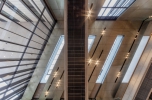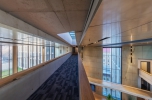Moving out from the Castle
MTA Research Centre of Arts and Social Sciences, Budapest
Architects: Tamás Noll, Attila Madzin, János Golda
Text: Anna Szövényi
Photos: Tamás Bujnovszky
In accordance with a governmental decree passed in 2013 several research bases of MTA (Hungarian Academy of Science) also had to move out from the Castle district. The objective is to integrate the building stock into a new „smart” structure instead of the numerous old ones which are difficult to maintain. A building site with appropriate dimensions for this purpose was found along Soroksári Road where a mill had stood before. As a new stage of the development of Budapest, the sites of mills in the southern region of Pest undergo changes that transform them. The lane along the Danube where the new MTA building is located shall soon develop to keep pace with the Inner City. Designers launched the building with a transparent hall wedged between the two blocks as well as a surrounded and retraced reception area. This design draws attention towards the inner world of the centre. Space opened upward and narrowed down backward evidently suck us in and attract us. The high corner design of the building also functions as a space marker whilst also symbolizing the power and significance of sciences. This section houses the library which is the essence and collection of knowledge. Starting out from the main building the cut-away horizontal configuration reoccurs on the tracery of lines at the back of the building. The volumes thus ensuing appear dynamic and communicate with the exteriors in a unique way. Every unit has at least two or three links to the outside which differ in nature and character. This kind of multi-spatiality and variety of aspects help the work of people here, enhance their feeling of comfort, and provide extras with their approach to space that may also inspire innovative ideas.
The interiors of the building are also targeted to give more than an average office block. Such components are the „superfluous spaces” left out on every floor in the office block, which can function as and transform into lounges or communal areas for research teams later on. The same holds true for the gallery which breaks the monotonous levels of the library. And similarly, the seemingly superfluous, but excellently exploitable space is the gallery level of the entrance hall, which can evolve into a secondary informal communal area used exclusively by people working here. The double-width corridor also has left-over spaces at its end on each floor, which could be used by researchers of the same field for discussions and meetings. The various branches of science have the chance to meet in the joint separate hall and the restaurant on the ground floor, whilst those wishing to keep in touch with the world outside the building can use the entrance area of the entrance hall and the conference room housed on the ground floor.
Leading architects: Tamás Noll, Attila Madzin, János Golda
Project architects: Ágnes Légár, Ferenc Károly
Fellow architects: Zsófia Szűcs, Andrea Szabó, Eszter Bagdy, Ádám Kern, Szabolcs Kriston, Mihály Eszik, Balázs Vörös
Interiors: Rózsa Csavarga – Sandroza Kft., György Major – Teamajor Kft.
Lamps, overlays: Szandra Szentgyörgyi
Climatic facade: György Stocker – Stockplan Kft.
Structure: Péter Suhajda, Árpád Molnár, Krisztián Molnár – M-Teampannon Kft.
HVAC: Csaba Kordé S., Balázs Kordé, Györgyi Andrejszki; Ferenc Kesztyűs – Cse-Ko Kft.
Electrical engineering: Ferenc Rajkai, Péter Bárány, Gábor Balán – Hungaroproject Mérnökiroda
Landscape: István Steffler, Eszter Szentesné Dandé – Garten Studio
Outdoor public utilities: Attila Bíró, Gábor Hanczár – KÉSZ Tervező Kft.













